Regina Cyclone
The Regina Cyclone, or Regina tornado of 1912, was a tornado that devastated the city of Regina, Saskatchewan, Canada, on Sunday, June 30, 1912. It remains the deadliest tornado in Canadian history with a total of 28 fatalities. At about 4:50 p.m., green funnel clouds formed and touched down south of the city, tearing through the residential area between Wascana Lake and Victoria Avenue, and continuing through the downtown business district, rail yards, warehouse district, and northern residential area.
| F4 tornado | |
|---|---|
 Metropolitan Methodist Church and YWCA after the Regina Cyclone | |
| Formed | June 30, 1912 4:50 p.m. CST (2245 UTC) |
| Max. rating1 | F4 tornado |
| Damage | $4.5 million CAD |
| Casualties | 28 fatalities |
| Areas affected | Regina, Saskatchewan |
| 1Most severe tornado damage; see Fujita scale | |
Meteorological synopsis
The tornado formed 18 kilometres (11 mi) south of the city and continued for another 12 kilometres (7.5 mi) north before dissipating. It was approximately 150 metres (490 ft) wide.[1] The tornado's wind velocity has been estimated at 400 kilometres per hour (250 mph),[2] though this conflicts with the F4 Fujita scale estimate based on reports of damage and historical photographs.[3]
Occurrence
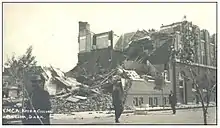
The tornado hit Regina at approximately 5:00 p.m. on June 30, 1912. The tornado formed 18 km south of the city and was roughly 150 metres wide by the time it reached Regina. The worst damage was in the residential area north of Wascana Lake and the central business district. Many buildings, both brick and wood, were entirely destroyed. "The new Central Library building was opened May 11, 1912, and just six weeks later, the new library was among the many buildings that suffered damage."[4]
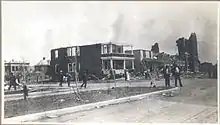
"In just twenty minutes it completely leveled a number of houses, and caused other houses to explode as the pressure inside the structures rose when the tornado passed overhead."[5] The affluent residential area to the south was substantially diminished, but the tornado left houses untouched here and there immediately adjacent to houses which were flattened. "[I]n the warehouse district, it destroyed many of the storage buildings. The CPR Roundhouse was stripped to the rafters, and boxcars were pulled from the tracks and hurtled into the air."[6]
Such damage was especially appalling to see as well as experience since Regina had been built on an entirely featureless plain, lacking any trees or vegetation other than natural wild prairie grass and without any hills or rivers apart from the tiny spring runoff Wascana Creek, which only flowed in early spring.
"The cyclone claimed twenty-eight lives and was the worst in Canadian history in terms of deaths. It also rendered 2,500 persons temporarily homeless, and caused over $1,200,000 in property damage. It took the city two years to repair the damage and ten years to pay off its storm debt."[5]
Aftermath
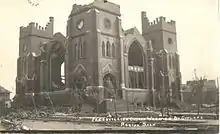
The city forced those rendered homeless by the disaster to pay for the nightly use of cots set up in schools and city parks. It also required homeowners to pay for the removal of rubble from their homes.[7] Debris was cleaned up quickly. "The storm damaged the Metropolitan Methodist Church, [the Knox Presbyterian Church, the First Methodist,] the library, the YWCA [and YMCA], and numerous other downtown buildings; in the warehouse district, it destroyed many of the storage buildings. The CPR Roundhouse was stripped to the rafters, and boxcars were pulled from the tracks and hurtled into the air."[5]
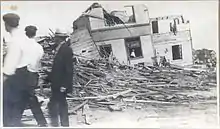
Damage from the tornado is estimated to be F4 on the Fujita scale. The tornado killed 28 people, injured hundreds, and left 2,500 people homeless, out of a population of about 30,213 (in 1911). Around 500 buildings were destroyed or damaged. Property damage was quantified at $1.2 million CAD,[8] and it would be forty years before the $4.5 million CAD private and public debt incurred to rebuild and repair was repaid.[9]
The only remaining "souvenir" of this event is different-coloured bricks on the north wall of Regina's Knox-Metropolitan United Church (the building of the pre-church union of 1925 Metropolitan Methodist), showing where the wall collapsed and was rebuilt. Knox Presbyterian, Metropolitan Methodist and First Baptist, all being brick, were quickly rebuilt. Knox and Metropolitan both became United Church in 1925, and merged their congregations in 1951 and became the Knox-Metropolitan Church. The Knox building was ultimately demolished.
Boris Karloff's connection
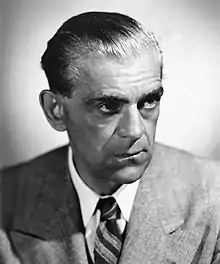
English actor William Henry Pratt, better known by his stage name "Boris Karloff", was in Regina at the time of the tornado as a member of the Jeanne Russell Players, a struggling company of actors and singers. Theatre reviews appearing in at least four Western Canadian newspapers in 1912 prove he had already started using the stage name "Boris Karloff" by this time.[10] The Jeanne Russell Players disbanded in Regina a day before the tornado struck, leaving Karloff stranded and broke.[11] Following the tornado, he worked clearing debris for twenty cents an hour and was later employed in Regina by the Dominion Express Company. He remained in Regina until October 1912 when he joined the Harry St. Clair Players in Prince Albert. In 1958, Karloff appeared on the talk and game show Front Page Challenge[12] where he was featured not because of his fame as a Hollywood actor, but because of his association with the Regina Cyclone of 1912.[13]
American stage actress Henrietta Crosman, who also later went on to Hollywood, was also in Regina at the time of the disaster and toured the devastation with members of her troupe.[14] Her company staged a benefit performance of Catherine Chisholm Cushing's comedy "The Real Thing" at the Regina Theatre (12th Avenue and Hamilton Street, previously on the site of the old Hudson's Bay department store, opened in 1910) on July 4, 1912, with a portion of the proceeds going to the tornado relief fund.[15]
Over the years, some historians have mistakenly placed Karloff as a member of Crosman's company or as a member of the vaudevillian Albini-Avolos Company, which was a third theatrical troupe in Regina at the time of the 1912 tornado. The Albini-Avolos staged benefit performances for the tornado victims at the Regina Theatre on July 1 and 2.[16]
Popular culture
Boris Karloff, Jeanne Russell, Henrietta Crosman, and the Albini-Avolos are all characters in BD Miller's musical drama, "Swept Off Our Feet: Boris Karloff and the Regina Cyclone", which commemorated the 100th anniversary of the disaster and premièred as a July 2012 production of Regina Summer Stage.[17]
The novel Euphoria by Connie Gault won the 2009 Saskatchewan Book Award for Fiction and prominently features the Regina Cyclone.
Gallery
 Winnipeg Elevator after the tornado
Winnipeg Elevator after the tornado Warehouse district after the tornado
Warehouse district after the tornado Side view of Princess Theatre after tornado
Side view of Princess Theatre after tornado Regina Tornado June 30, 1912
Regina Tornado June 30, 1912 Regina downtown after tornado
Regina downtown after tornado People in front of damaged building
People in front of damaged building Metropolitan Methodist Church after the tornado
Metropolitan Methodist Church after the tornado Damage to Metropolitan Methodist Church
Damage to Metropolitan Methodist Church North end of Regina after tornado
North end of Regina after tornado Downtown stores damaged by tornado
Downtown stores damaged by tornado Destroyed Winnipeg Elevator Company buildings
Destroyed Winnipeg Elevator Company buildings Damaged office building after tornado
Damaged office building after tornado Damaged homes on Smith Street
Damaged homes on Smith Street Damage to the YWCA immediately north of Metropolitan Methodist Church on Lorne Street
Damage to the YWCA immediately north of Metropolitan Methodist Church on Lorne Street Damage to buildings after the tornado
Damage to buildings after the tornado Damage to businesses after the tornado
Damage to businesses after the tornado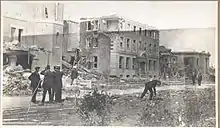 Damage to buildings on Lorne St.
Damage to buildings on Lorne St. Damage caused by the tornado
Damage caused by the tornado
References
- Paul, Alexander H. (May 1995). "F3 and F4 Tornadoes in Saskatchewan" (PDF). Report to SGI. Saskatchewan Tornado Project, University of Regina. Retrieved 2011-05-02.
- Bingaman, Sandra (2011). "Storm of the century: the Regina tornado of 1912". National Network for Equitable Library Service. University of Regina Press, 2011.
- "Canada's Deadliest Tornadoes". Retrieved 2011-05-02.
- Regina Public Library http://www.reginalibrary.ca/about/history.html. 23 June 2012.
- Dagmar Skamlová' "Regina Cyclone." The Encyclopedia of Saskatchewan. "Archived copy". Archived from the original on 2011-08-26. Retrieved 2011-05-02.CS1 maint: archived copy as title (link)
- Dagmar Skamlová, "Regina Cyclone", Encyclopedia of Saskatchewan, "Archived copy". Archived from the original on 2011-08-26. Retrieved 2011-05-02.CS1 maint: archived copy as title (link) viewed November 29, 2012.
- "Regina Tornado - June 30, 1912". SOS! Canadian Disasters. Library and Archives Canada. 2006-02-14. Archived from the original on October 1, 2007. Retrieved 2011-05-02.
- "Cyclone of 1912". Regina: The Early Years. Saskatchewan Council for Archives and Archivists. Archived from the original on 2011-05-14. Retrieved 2011-05-02.
- "Presbyterian Church after Cyclone, c. 1912". City of Regina. 2010. Archived from the original on 2009-06-28. Retrieved 2011-05-02.
- From February to May 1912, the name "Boris Karloff" appeared in theatre reviews published in the Lethbridge Daily Herald, Regina Leader, Saskatoon Daily Star, and Saskatoon Daily Phoenix.
- Saskatchewan: A New History, Bill Waiser, Fifth House Ltd., 2005, p. 161.
- "TVarchive.ca Episode Guide—Front Page Challenge".
- Front Page Challenge: History of a Television Legend by Alex Barris (Macmillan Canada, 1999), p. 64.
- "Miss Crosman in 'The Real Thing': Charming Actress Sympathizes Deeply With Sufferers From Storm", Regina Leader, July 4, 1912.
- Regina Theatre advertisement: "Benefit Performance by the Distinguished Comedienne Henrietta Crosman", Regina Leader, July 4, 1912.
- "Benefit Nets $150 for Storm Victims: Albini-Avolos Company at Regina Theatre Play to Packed House", Regina Leader, July 2, 1912.
- "CBC News: Boris Karloff and Regina tornado theme of new play".